CAMERON HIGHLANDS, MALAYSIA
2016-06-15, 22:46, JASON
BUDGET , STAY: CAMERONIAN INN, TANAH RATA
There's not much information on a budget way to get to the Cameron Highlands, but there's plenty of information on making your trip affordable when you arrive. Naturally then, the journey started with the conceptualization and planning of our trip, which was all somewhat ad libbed
Flights into Ipoh, the nearest main city with an airport, are expensive round trip. That rules out flying to Ipoh. The round trip option into KL is affordable, but you would be about 200km out as opposed to 80, a considerable difference if you're only spending a weekend in the Highlands and need to minimize transport time. The money you'd spend in gas and logistics would hardly be worth the effort despite the cheap gasoline. Plus, it's not all smooth roading to the top -- you're driving around the mountains, diminishing down the time-to-distance ratio. Scratch KL. So we went back to the basics. The cheapest way, absolutely, into Malaysia from Singapore is by bus. If you're pleb-chic you'll opt for this one, comfortable in the fact that you're cheap and can get in for a deal. The (arguable) tragedy is you're in a bus for 9 hours, with stops in between KL and the occasional manned gas station. This is a matter of perspective, though. I'd call it an adventure. There's comfort when you take a bus into Malaysia since all you worry about is getting off for immigration. The rest is loud Malaysian music, comfortable A/C, and an 'included' tour of the landscape. It also serves as a way to utilize the night hours if you're short on time. The decision then was simple and out of necessity: Take an overnight bus from Singapore to Ipoh, the closest major town to the Highlands. Bus out overnight back to Singapore.
Road block two: Ipoh is not as developed for tourists. Another matter of perspective. Hassle, or challenge, take your pick. There are car rental companies in Ipoh though, and, given their obscure status, the laws here are relaxed. All the riffraff you deal with booking in the West? Nonexistent. They took American drivers licenses (check), supplied insurance (check, although we're not sure what kind), and they took credit card (Visa, which, if your card has included insurance, is always a good backup. This is Western suspicion on my part). The booking was made completely over WhatsApp the Wednesday before we left; we'd left on Friday. I gave him my schedule, we had some exchange of broken English and the occasional Bahasa Melayu, and the car was booked. They were flexible, too. We weren't sure when the bus arrived in Ipoh. I gave an ETA of 6:30 a.m. and ended up arriving 8:40, and they, despite their fasting during Ramadan, were happy to accommodate. Business is business, I suppose. They picked us up at the stop to take to their company, not much but a small kampong-style house in the suburban area. We signed a form in Bahasa Melayu whose meaning eluded us. Hell, we couldn't even tell where to put our name, date, and sign. But, just like that, the forms were all set and we were given a Perodua Viva with about 1/4 tank of gas left. A low-cost Malaysian brand of car, the little thing served us well. It came with all the starters in any Southeast Asian car - A/C, a set of simple wheels, that infamous radio like on the bus, and a semi-responsible driver. We provided the last item. "Fill up the tank to how you found it." And we nodded. As we were about to leave, Thorin asked how to adjust the mirrors, looking for a button or automatic control. "Like this," the kind man said, as he manually creaked the side-view mirror to Thorin's satisfaction. I followed suit on the passenger side as Thorin took to the wheel. "OK, we are definitely now in Malaysia." (check).
If you read our Ipoh page from 2015, you'll know the landscape is stunning. Tall mountains covered in dense, green tropical foliage cover these rugged mountains, with the city occupying the valleys in between. On the drive towards the Highlands, you head down the "1" expressway and begin climbing into the mountain. What's even more stunning are the construction areas around mountains. The interior of the mountain, usually brown in color from the underlying rock, contrasts sharply with the dark green coverage. The dramatic change in physical composition is stark too, from the bushy bumps of the trees to haphazard, landslide-style rock. It's simultaneously jarring, but breathtaking.


If anyone has been to Napa, you'll know when you're near. You enter on one road and, at even the slightest higher elevation, you're able to peer over into the vineyards and begin to see linear structure to the landscape. That's how you know you're in grape country, and in a few hours will be drunk off some fine, sweet, dry, or however-you-like-it wine (I still don't believe in a tasting where you spit). The Highlands has that same aura. You know you'll be entering in when you see the landscape change. No more sharp mountain passes or construction, and the dust kickup from the car in front. It's tea country here up in the hills. What happens first is you begin to see the mountains take shape, much like the Napa fields. The planting of tea bushes is done so that it etches a cerebral pattern onto the mountain face. There's some underlying linear structure, but, as its etched onto the curvature of the mountain, it comes together like squiggles on a page, interjected often by taller trees.
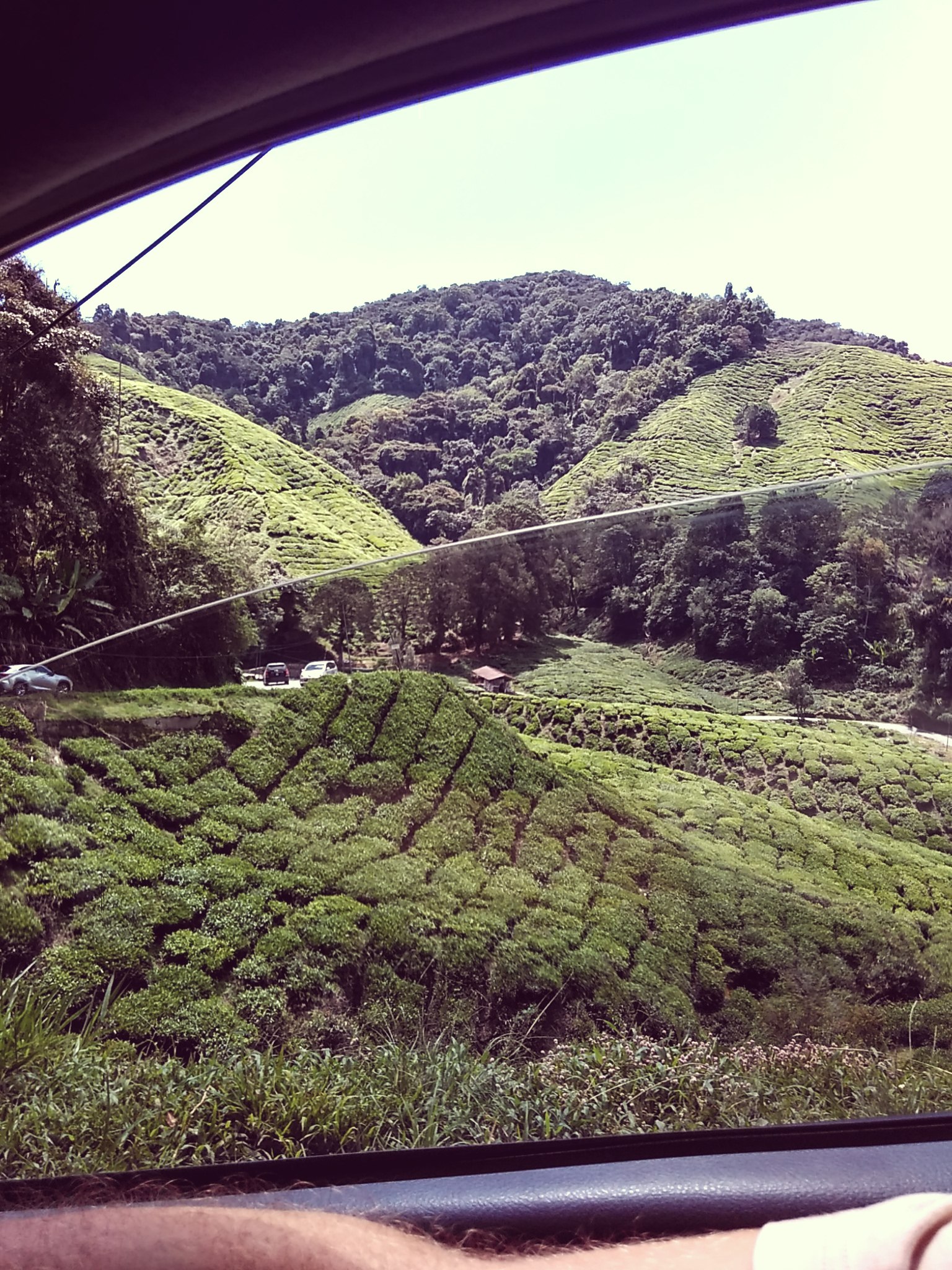
Within the Cameron Highlands, there are three main cities in a row, all about 5km or so apart. Coming in from Ipoh, we passed first by Brinchang in the north, then Tanah Rata, and Ringlet in the south. You first pass by some tea plantations, giving you the "Oh, we're close vibe." Then, what you see next is various forms of development. Hotels located on the slope of a mountain, housing units distributed across, built in their own unique Cameronian style, which takes a bit of explanation.
The human-made landscape is an amalgam of different styles. Imagine a ski chalet. Anywhere; Denver, Switzerland, or from Google Images. Picture in your head what it looks like, and where it's located. You roughly have an image: probably wooden, definitely with snow on it. Maybe a balcony or two so you can, I don't know, greet the people in the freezing cold. And, not just that, but there's something about being in the mountains, in snow, that is refreshing. It's the mountain air feeling. Next, take a British Tudor House, a popular medieval-style house. Usually a white exterior, with some brickwork or masonry laid on the exterior. Steep, sharply sloped roofs. The pure white is divided geometrically by lines of wood in some pattern, usually nonspecific, only to a standard that does not allude to disorder. It's quintisentially British: organized, with structure, and of a cuteness that can only be described as "So English." And now, take a Malaysian Kampong house. Low-rise, usually built bordering closely next to the neighboring abode. Like the Painted Ladies, with less fame. It's a practical structure, built for function and living. It's built to tolerate the rain, and the heat in the tropical belt. It does not deal with the non-necessities of life thus making it a very modular style of house. And this mixed together characterizes the landscape. You're in a small, mountain side string of towns. It has a mountain-town air to it, much like when you go to Tahoe. Everything's cozier, a bit smaller, more cool in temperature. But, the temperature isn't freezing -- remember, you're in Southeast Asia. It's a bit cooler at mountain-altitude but it's very temperate, like a warm day in Denver, or Basel. This is thrown off by the style of housing you would associate with colder countries. Many of the buildings that are slightly higher (5 floors, six) are built in British Tudor style. For the 'HDB-style' houses (HDB is the goverment housing in Singapore, which are usually known to be sky-scraping modular boxes), which are still relatively low but packed in like cubes, they are all built in tudor-style, boasting a balcony that overlooks the main cities, much like the chalets. And, true to pragmatism, there is washing that is hung out on long, metallic poles anchored at the base, jutting out into the Malaysian air. On the outskirts of the main town, you get smaller houses that range from Kampong-esque to San Franciscan. So, what I characterize as "Cameronian" style is really a mix. It has the British influence from the colonization, noted in the architecture and the tea culture. It has that mountainous feeling you get in cities settled at high elevations. Topped off with the local style vibe breathed in by the friendly local Malaysians, and you have the Highlands. This was what we saw driving into the first main city, Brinchang.


You'll see a lot of signs for picking your own strawberries in the strawberry farm along the way. Apparently, this is also strawberry country, which we had not the foggiest clue. While most others will recognize it for its tea, keep in mind its forgotten complement, the strawberry. But, on that note, let's really move on to the tea plantations.
After checking into our inn in the middle town of Tanah Rata, we were recommended to return to Brinchang and go see the Sungai Palas BOH Tea Centre, the famous tea plantation in the Cameron Highlands. BOH is a famous Malaysian tea brand started (of course) by the British when they settled into the area, and they have converted some X acreage of land into tea valley. Upon driving up, that familiar sight of the mountains planted with tea bushes, but this time there were less buildings going up. The turn-in road to drive to the BOH Centre was inconspicious, a small turnoff from near the bee center / apiary (also a 'thing' in the Highlands). As you go up, many parts of the road become one lane, and you navigate across alongside large agricultural tractors, other cars, and school buses, all containing people who want a glimpse of the famous landmark -- literally. The trick is, if you're not comfortable with the road, to take the smallest car possible so you can sneak through corners and dodge cars easier. We were glad to have rented a Perodua Viva, small enough for the job and cheap enough for the wallet.
Winding all the way up, we slowly made our way deeper into the mountain, and further up. With every turn, we were exposed to more tea bushes and farming practices on the hillside. The weather was stunning, a nice bright 25 Celsius with the sun shining, hitting the mountain at an angle as to light up the plantation perfectly. It looked like a cross between the Shire and Napa. It'd been a while since we had the windows down, taking in the breeze and just forgetting about the worry. The only thing different was the Chinese music on the radio, we had acquired that taste recently. And, after what seems like a lifetime since we were engrossed in the landscape, we finally arrive at another unassuming parking lot. The road had just ended like that, with a security officer standing near the entrance to the parking lot. "No fee to park." Good, as it should be. For a popular tourist attraction, it wasn't as overrun as we were expecting, probably given it was Ramadan and fasting time for the Malay locals. We shoved the Perodua into a small nook of a parking space, and then began walking. The first thing we saw, "Trail to BOH Tea Centre."



The trail didn't last more than 5 minutes. It couldn't really be described as a trail, probably moreso a pathway. But, that in itself is what was nice. They didn't bother to overdecorate the area because the place speaks for itself in terms of grandeur. There was no aimless placards describing the place, or the plants, just a few posters describing the history of BOH and then a small gift shop tucked away at the visitor center. They figured out that people, by the time they reach the café at the top, through the hills and up the path, really only want a nice slice of cake and a pot of freshly brewed Cameronian tea, and that's exactly what they provided. Again, true Malaysian grit: practical and not overzealous. Mirrored not any less through their architecture, and their car contracts. It made our lives a lot easier and enjoyable.
Scones are a thing with British Tea, as I've come to learn dating Thorin. Actually, any sort of cracker, biscuit, scone, or general carbohydrate goes well with a cup of tea. At the top, we ordered an apple pie, a strawberry pie (see, it's a thing), as well as a pot of Gold Blend BOH tea and just sat in the café that overlooked the highlands. It had a glass perimeter that allowed you to look out, and for the sun to look in. Slats were provided on the glass so that air could easily pass through and cool the building. On the far end, an overhang lingered over the tea bushes so you could get the vantage point of the whole plantation. I'd call it "Modern Architecture" as an all-encompassing term. They did it so effortlessly




Since we couldn't get enough of the mountains and our rental, we decided to continue deeper in. Taking a detour, we drove up to Gunung Raja which was a vantage point deep into the mountains, nearby to the Sungei Palas The drive was tough, with weakly paved surfaces climbing at nearly 30 degrees from flat, and we had to do it with our tiny little car with a low rise from the ground. Every once in a while, we would anticipate the next obstacle, take a conscious breath, and realize we were in the jungle now, far from the plantations. But, getting up there we were able to stroll along the mossy forest, whose forest floor was covered with moss, as well as the electrical tower at the top for a vantage point of Pahang state in Malaysia. And just like that, you're reminded of the plantations and that you're back in Tea city. Up there, too, you could see the divide between Pahang and Perak state, home of the Cameron Highlands and Ipoh, respectively. As it is with borders, it's a non-dramatic divide. Just an electrical tower with a man who works there, sitting on the Perak side, nothing else that's glamorized. Traitor.


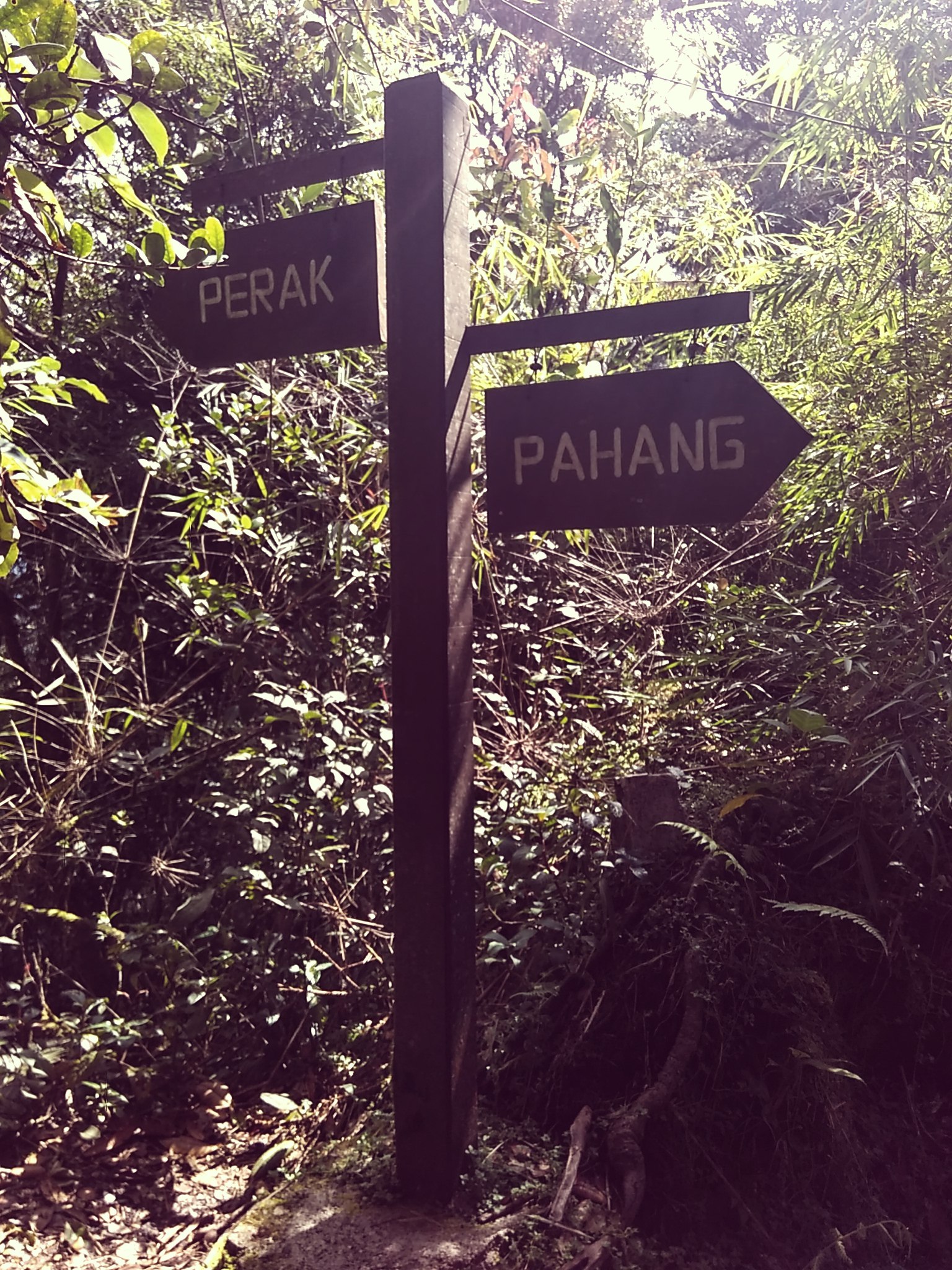


Heading out, we encounter some more traffic since people want to visit Sungai Palas before it closes. We get stuck along the one-way roads for about twenty minutes, but as Malaysia goes, you sit patiently. Rarely do you hear a car honk, as opposed to in Singapore when you're woken up by them every morning. There are only four cars in front of us, one being a Bas Sekolah -- schoolbus -- and everyone sits and anticipates what exactly it is we're waiting for. Twenty minutes later, a huge tractor carrying dirt for the plantation strolls by. "Oh, that's why." And, after that, everyone is on their way again. I'm thankful for the little moments like that that make the trip special. They serve as great opportunities to snap a few pictures. As it neared 16:00, we drove back down towards Brinchang, the first city in the string of three. On the way was a lovely small market that was selling fresh fruits (can you guess which ones) as well as some local fried Chinese bits. We had some sweet potato balls, fried mushrooms, and a cup of corn.

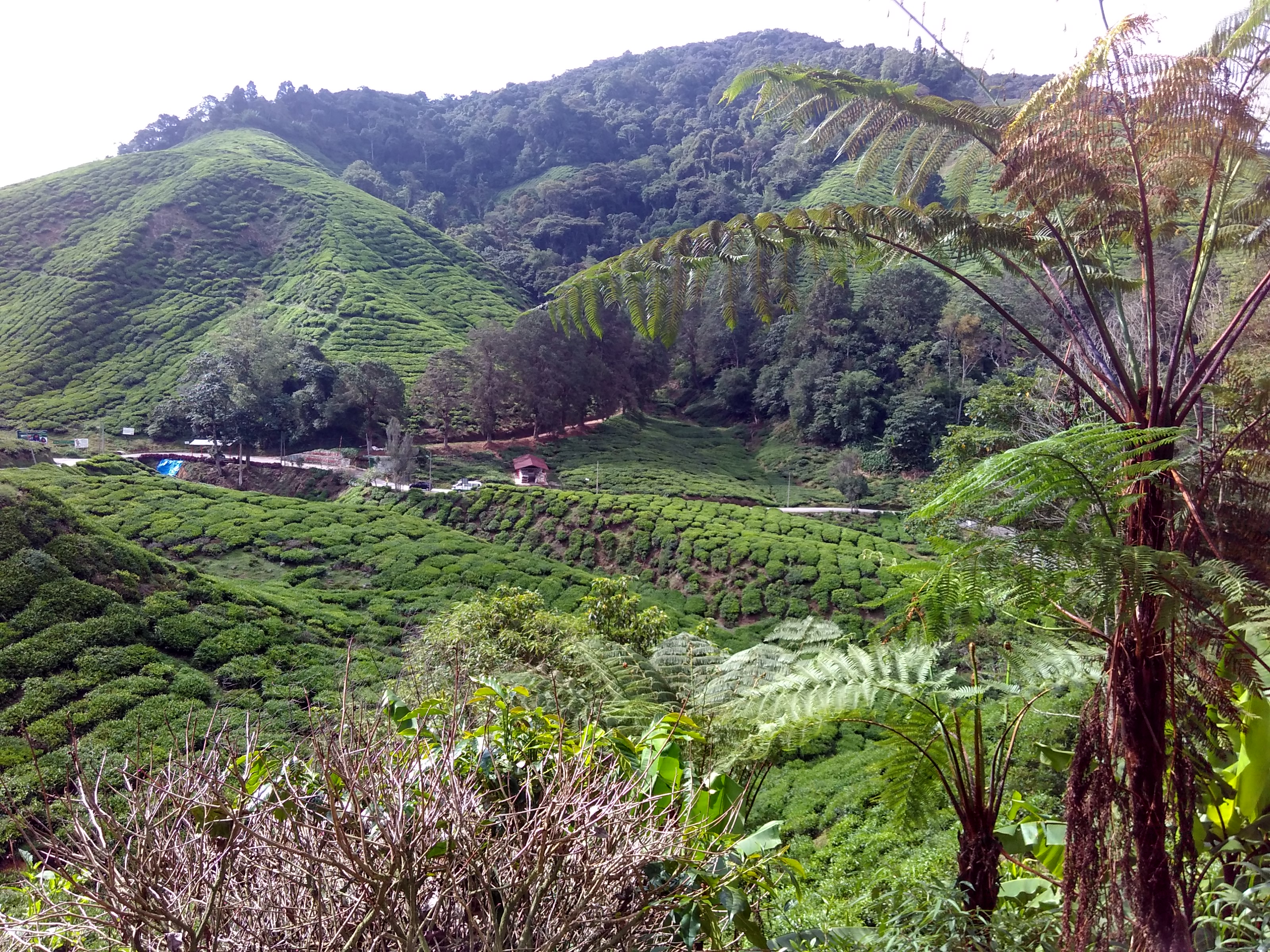

For those that don't know, Ramadan is the fasting month for Muslims around the world. Based on the Islamic calendar which is shorter than the solar calendar by roughly 10 days, the date for Ramadan constantly shifts earlier in the proceeding year. Last year, we were in Ipoh and Penang for Ramadan, and this year we have come full Islamic calendar circle to celebrate it in the Cameron Highlands. What does that mean? Food, and lots of it. Of course, not during the fasting portion of the day, but during break fast, one of the most beautiful testaments to faith and unity. I'm not particularly religious, but it's the one time of day that everyone gets together to eat and break the fast for the day. Many sit around a circle, with a picnic laid out, and eat together. It's communal and there's a sense of togetherness. This is also around the time where Malays will come together and set up their Pasar Malams, Melayu for "Night Market." As Muslims prepare to break fast, and well into the night, they will get food to enjoy together. As a tourist appreciating from the spiritually afar, this is a great time to stroll the busy markets and eat some delicious Malaysian food. From the kuehs, to the various ayam (chicken) dishes, there's no room to store it all in you, but we had to find room given we were there for a few days. Stuff now, worry later.
To discuss the other pasar malam, I have to precede with a slight political discussion. Much like Singapore, Malaysia has had its fare share of racial tension, with ethnic Malays, ethnic Chinese, and ethnic Indians. All hold the title to the Malaysian identity. In Singapore, the same ethnic compositions are noticed but dealt with differently. In dealing with potential interethnic tensions, Singapore integrated public institutions (schools, housing arrangements) with ethnic quotas to avoid ghettoization. That, plus they fed a spoonful of multiethnic and culturalism rhetoric to the public, and on the surface all problems were solved. Malaysia has had a more tumultuous time with the issue, with the dominant Malay group calling most of the political shots (that, and their affiliation to the national, Sharia law). However, it's interesting in that on the ground, I see more interracial friendships among Malays (as a national group, not as an ethnic group here) than I do Singaporeans. That is to say, I see Chinese mingling with Indians and ethnic Malays on the ground, whereas I rarely see this in Singapore. Perhaps this is especially pronounced in places like Ipoh and Cameron Highlands, in which the percentage of Chinese and Indian folk are visibly higher than on the east coast. The point I'm laboring is that there is some noticeable segregation on the ground, and that is noticed in the pasar malam. In the town of Brinchang, one side of the road is the Chinese Pasar Malam, and the other side of the road is the Malay one. The patronage composition largely clusters around the specific ethnic malam, but there is some mixing. What does this mean for the foreigner? One, do not get involved in the politics unless you know what you're talking about. Two, there are two sets of cuisines to eat, all of which must be eaten. So, we first went to the Chinese pasar malam, had a bowl of delicious Assam Laksa, more sour than the Singaporean variety. Then, we hopped over to the Malay side to have a bit more to eat. Jackpot!


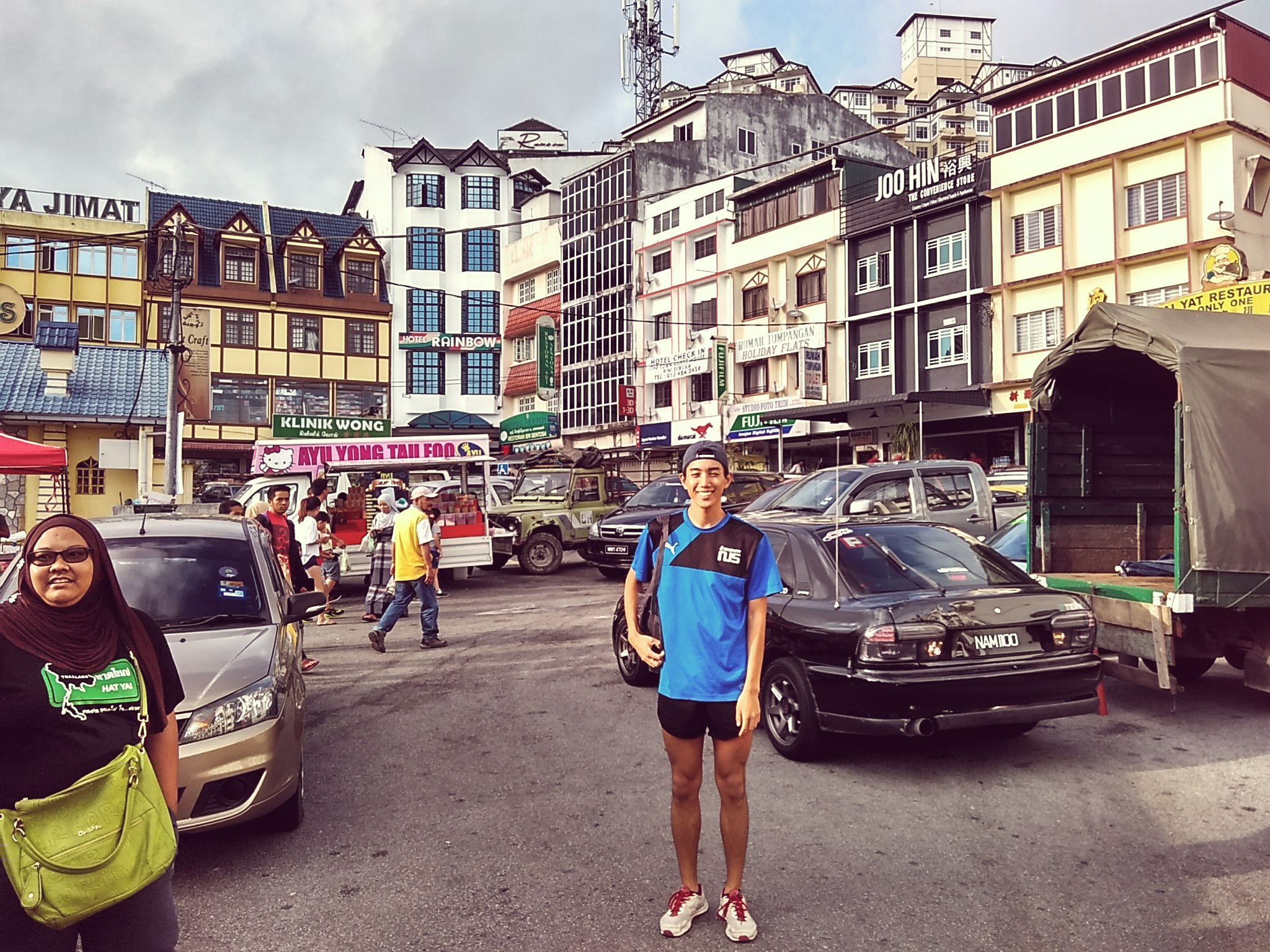
More into racial identity, the Chinese here all moved prior to the communist take over of Mainland China. As such, they have maintained a cultural identity similar to the Chinese past before communism erased much of it. What that means is most ethnic Chinese in Malaysia will be some sort of dialect speaker, with ethnic origins in the south of China. In Ipoh, it's Cantonese, as I was told by my hairdresser in Singapore. I'll take her word for it since she was from Ipoh. In the Highlands, I'm not sure which is dominant but I can't understand. What I can understand is that with their language and culture comes religion, and all the beliefs, practices, and architecture that come along with it. In the Ipoh post of last year, I touched on these wonderous castles tucked under the vast mountains, which were gorgeous. What is the local style in Cameron Highlands? Just a really, really big Buddhist temple. In fact, the fourth biggest in Malaysia. This was tucked away into the side of Brinchang, and we had only discovered it when walking around after having eaten too much at the pasar malam, peering through the low rise kampong-style village behind. We decided to go for a hike towards it, and were faced with the "Three Precious Buddhas" temple overlooking tiny Brinchang. Inside, monks of both genders, praying. The halls are a bit empty as sundown is nearing and there's a calm to it. I think it's that fresh mountain air that blows through the wide halls of the temple.
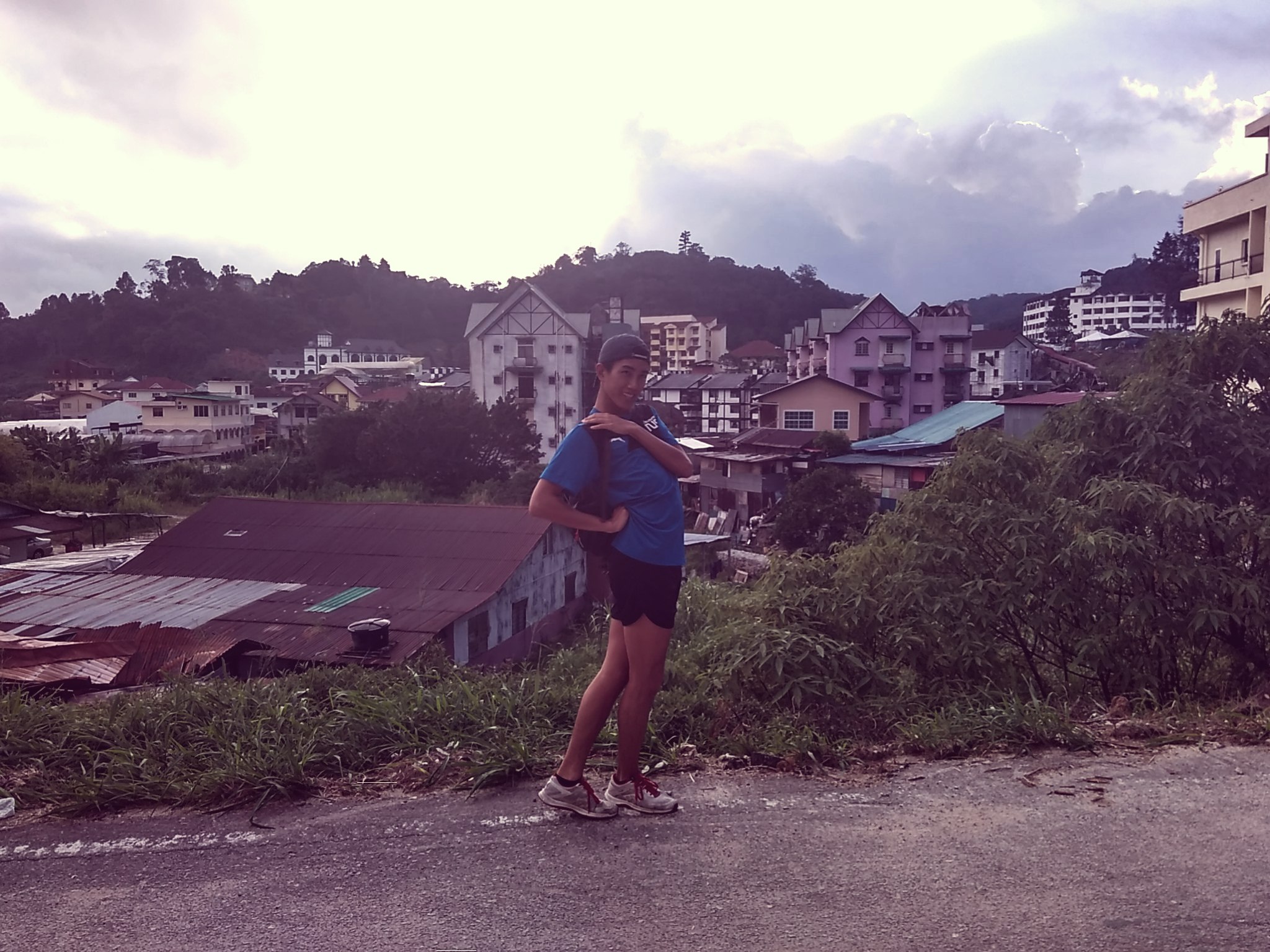



As it got dark, we decided to head back down to Tanah Rata, only a few km away, to bring in the night at ease. We got back to the hostel, and the helper, a lovely Chinese Malaysian man, recommended us to a nice steamboat restaurant in the Highlands. Of course, the last thing the Chinese took here was their food among everything else, as it would be almost a pure offense to the Chinese existence if the culinary tradition wasn't continued on in the diaspora community. So, they took with them the most appropriate food for the mountains. What works well in the cold winter months, and the cool summer months? Some call it hot pot, here, it's steamboat. At 20 Ringgit per person, you are able to get a set meal that includes meat, seafood, tofu, noodles, and various other foods with two soup bases: tom yum, and chicken. Tom yum seems to be a big flavor here, not sure if that has something to do with the Thai influence up in the north. In any case, we don't question culinary history. We experience it. Despite eating tons at the malams before we somehow found room to stuff a large portion of steamboat in. Expensive, yes, relative to the other stuff, but worth it. We slept well that night, with the exception of two loud British girls right across our hall. Not sure if they were laughing or crying, but by the end of the day we were so exhausted their shrill voices became nothing but a small echo. We slept heavy, too, but that was the food talking.


A great journey always involves a friend along the way. The Chinese Malaysian Man, Mr. Yen, was helping around the hostel when we checked in the day prior and when we checked out in the morning, after trying some of their home made scones. He grew up in KL, and had seen the Highlands go from a small, backwater mountain town with friendly locals to a tourist destination in the backdrop of a Malaysia that is growing more conservative. He discussed with us about ethnic relations in Malaysia, and his belief that Singapore has done a better job integrating the races compared to the government. Interesting to say the least, as this contradicted with my observations as a tourist on the ground. He expressed, in a rather neutral tone, the opening up of the Highlands through three additional roads from the other cardinal directions relative to the 'center' of the Highlands - Tanah Rata. He expressed frustration about the overloading of tourists without the proper infrastructure to accommodate for them. He shared about Malaysia as a great site of tourism back in the 'true backpacker days' before Laos, Cambodia, Myanmar, and China opened up to much of the foreign tourism. An interesting man, and a short conversation as we were on the way out, but nevertheless great insight into the politics and the place which we were visiting. It brought a lot more color to the already colorful landscape.
Sungai Palas is just one of the tea plantations. It's the main one, the one with the stunning views, a larger dedication to the cultural preservation of BOH. The other plantation area is south of Tanah Rata, about an additional 15 km drive. I was thinking that one tea plantation couldn't be totally different from the other, but I was wrong. The drive up for this second plantation (I'm still not sure if it was the BOH Tea Planatation, or what it was called exactly) was a lot more rural. The road was even more narrow than the previous one, and there wasn't as much traffic since it was further out from the main town. Winding up, you would see small shacks as well as housing dormitories for the workers on the plantation. The feel was more personal and uncatered: you could imagine workers here waking up every morning to harvest the tea that the rest of the country enjoys. Once you reach the top via car, you have to either take a shuttle school bus or walk up through another 0.5km before reaching the top. We opted for the bus experience up and a walk down.
This Centre was also not as well catered to tourism, not that it should be. You walk to the top and there is only a small café, dwarfed in comparison to the one in Sungai Palas the day before, with no significant view of the fields. You are able to stroll into the factory behind the glass and read some placards that describe the tea drying process, otherwise, there wasn't anything else to do. The ambience of this plantation was set in a very natural way, and as a visitor you were only an observer to the process, watching the laborers sift through the tea like they were the main attraction in an occupational zoo. There were no walks being done around the plantations, and from this general portrayal of the process there was some beauty to it. Behind the nice packaging and all the fancy concept and ceremony around tea, there were the laborers, the fields, and the machines that made a dry, rotted leaf. And that was all. However you reacted to that was up to you. One man complained that there wasn't much to do up in the plantation. What was he expecting, a roller coaster? Doesn't matter. We were expecting some more delicious scones and nicely brewed mountain tea, so we helped ourselves to the café and ordered a Cheedling and some Orange tea, each with a scone set. Pricy, at about 13 Ringgit in total, but it'd been too long since we had scones prior to the Highlands. This was our guilty endulgence. Satisfying that craving for Sainsbury's scones that I've had for the past year and a half. 13 Ringgit was hardly anything. And that, folks, is privilege.


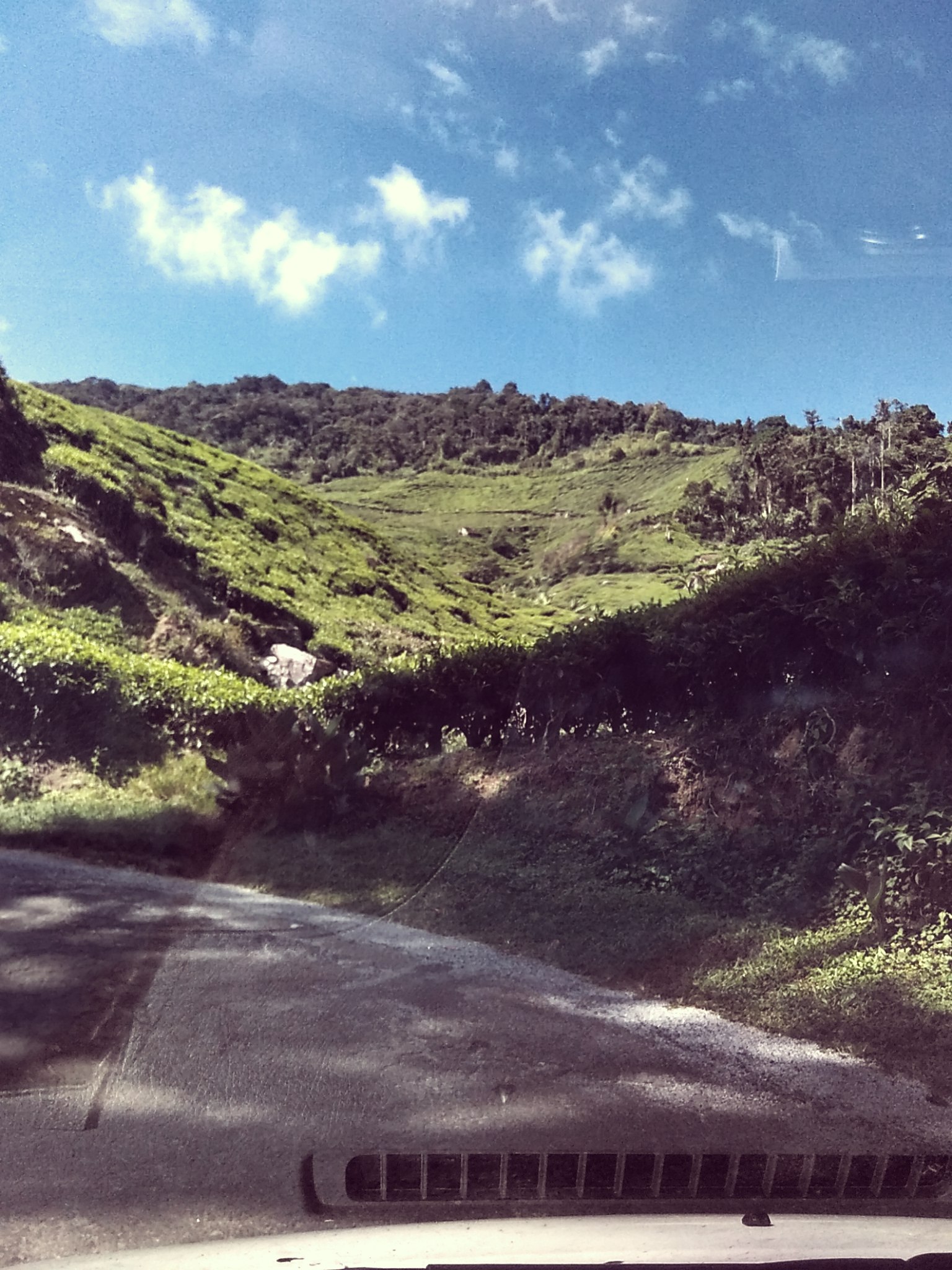



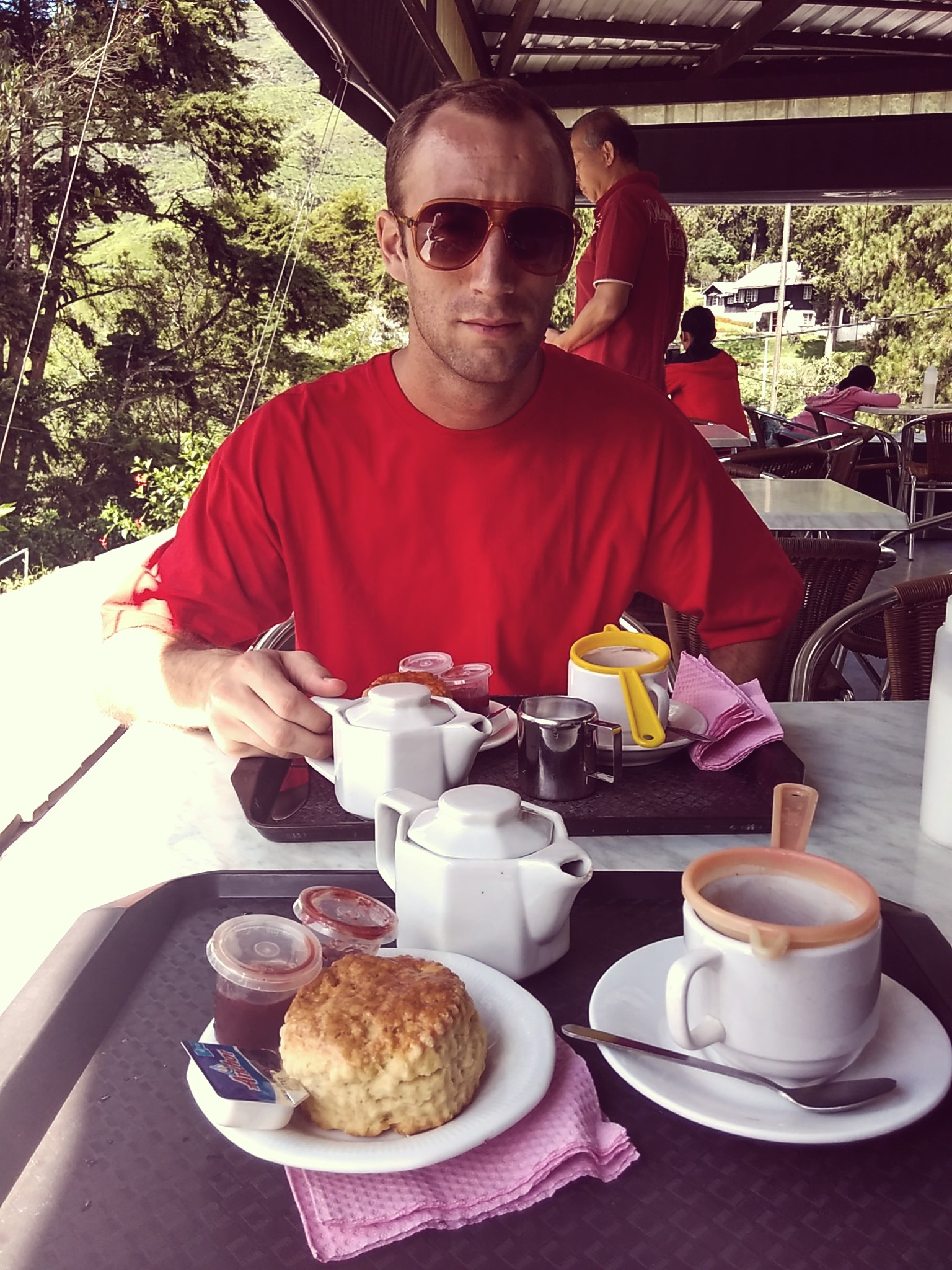

The walk down was beautiful as well. Without words, really. The pictures capture it a lot better.
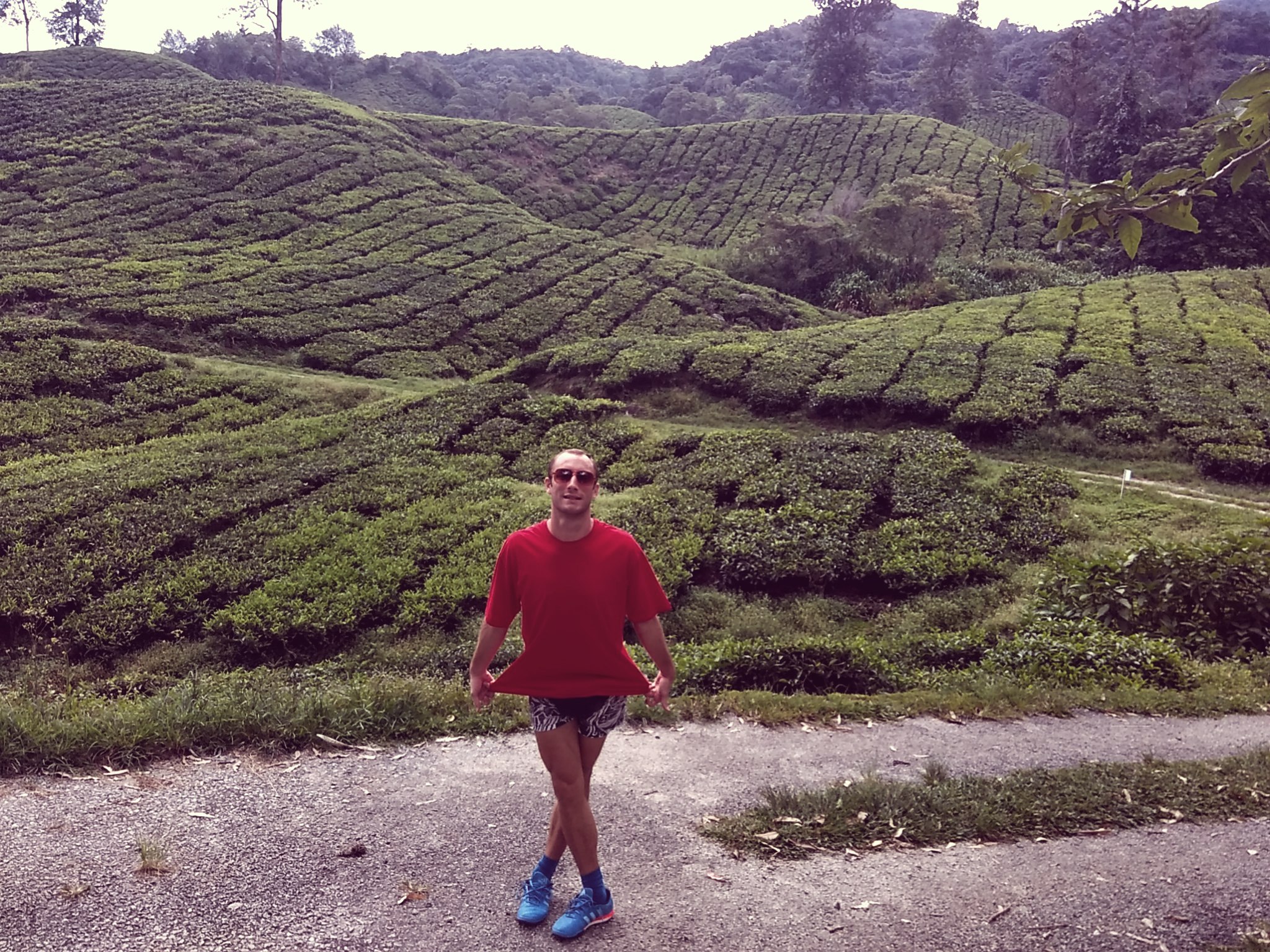

And, on the drive down, what do we see? If you've read the entirety up to this point, you should know.

The last place we wanted to go to was Ringlet, the last of the three big cities in Cameron Highlands. This one is the furthest south from the major resorts. It is also the most run down and desolate. A one road street with a gas station and a couple of old houses turned into shops with traditional Chinese spattered across them. Just like any other one-road towns you pass by, with people getting on their lives, a couple of restaurants open (Indian and Chinese, since the Malays are fasting), as well as a -- what is it? -- yes, you guessed it, another temple. The eerie thing about this one was that there was no one there. Usually, you will see one worshiper or someone presiding over the temple, but this one was barren. Thorin and I were the only ones there, and, unsure of how to really handle Buddha and the situation, we just overlooked the small town of Ringlet, then went on our way as the rain started coming down. Ringlet was rather small and uneventful. I'm sure there are more nooks to it, we just didn't have time to explore. And, as the unpredictable weather shifts began setting in, first with the grey clouds, then with the drizzling of rain, we thought we'd call it on Ringlet, and drive back up north to Brinchang, and eventually out of the Highlands.


I forgot to mention one last thing about the Highlands that they are known for. If strawberries were the forgotten brother, this was fourth wife in the line of concubinage. It's the bees. The apiary, home to the bees. Across the street from the road leading to Sungai Palas tea plantation is the famous Apiary of The Cameron Highlands. It has a free walking, self-guided tour (of course, why would they stray from the Malaysian way this far in..?) of the apiary in which bees are kept. When you enter, you are of coursed led into the gift shop, and are forced to walk through the shops until you can take a self walk of the actual apiary. When you get down, you walk by some little bee houses on wooden stilts and suspect those are there for display, but no, about two arms-length reach across from you the place is swarming with bees. Bees that are clustered and making that honey flow. As you walk along the garden, it's all outdoors and you are not protected, and you are standing there watching bees work, with the occasional bee flying by your face and around you, making its way to the next flower to pollinate or the next nest to work. You're not as worried about being stung though, since they fly from one post to the next. Scattered throughout the garden are also human-sized, plastic cartoon bees stuck on display with large bug eyes and a creepy smile, with color spots from what I assume is the rain and general wear-and-tear. Imagine Goofy, on a stick, supported by a round stand, with about two shades of color-fade so that the only life to the statue is the smile itself. It's a bit creepy, and there are about three to four of these 'bee statues' scattered in the garden as well. The aura is that of an abandoned theme park, kept alive by the pace and buzzing of the worker bees only. Again, on the theme of not catering to the tourist, I love it. The place doesn't need to be catered to anyone since it already stands with a purpose on its own. The honey is the bomb, too, don't forget to try some before leaving. If you're into it, there are some beauty products made of honey that you can try. I would just want to eat all of it..

Overall, the experience was worth it. Renting a car last minute, taking the bus, and being in awe of another side of Malaysia that we have not seen. Because we finished early, we wanted to head back into Ipoh, the city which we departed from, to see some of the things we missed from the last time we were there. So, as the post continues, I'll put in my thoughts about Ipoh. I've added an additional page to the "Ipoh" table of contents that will directly link to this next portion. There's no separate blog to cover Ipoh as we were only there for a few hours to burn time before catching the bus back to Singapore.
Ipoh, round two
The place hadn't really changed that much from when we last came. It's the same old downtown, the same old slow pace, and that same ol' sweet taste of delicious white coffee. Since we had traversed the city countless times last time waiting for our flight, this time we decided to travel more to the outskirts to see what the suburban side had to offer. A quick look on the WikiVoyage page led us to Kellie's Castle, some abandoned outpost along the highway that was unearthed from the dense, jungle foliage that had swallowed it up. The description was creepy enough for us to want to take a look. British colonialism has a strange way of working on the landscape, much like in the Cameron Highlands. They import their building styles, and adapt it with some local touches to the intricacies of the buildings, preserving both a strong sense of British culture, but being somewhat open-minded. As such, Kellie's Castle, the exterior, looks like an English chateau on the top of a hill, overlooking the Malaysian jungle ahead. However, inside, while still maintaining Britishness, has architectural inspirations from other cultures such as Indian and Italian. This is noticed in the tiling and designs. In fact, the constructor, William Kellie Smith, hired Indian Tamil laborers to do much of the work. Turns out, he died in the end due to some nasty strain of a flu, and the project was never finished by his wife either. Cue in some ghost stories about wandering spirits deep in the jungle, etc. The best part was that you could walk all around the castle, onto the roof and through the rooms, again, with few placards of information, to explore the castle grounds. They had left the skeleton open for exploration. It was a real Indiana Jones moment.


Back to Ipoh town center, it was just as we left it a year ago. There's a timelessness to this place. The buildings still burned, half empty streets, buildings gutted with dangling remnants of signs written in traditional Chinese characters. The smell of bean sprout chicken rice fresh in the air, the tourists congregating around the prostitution street. It was all so familiar. Any sign of prostitution or any form of life on that street after 18:00 was moot. The stores had all closed up, and the street had gone back to being deserted like before. When we walked out of eating our dinner, what was once a bustling street had closed all its doors as if a storm were coming. The only shops open were newly opened hipster cafes much like those found in Johor Bahru, Singapore's neighboring Malaysian state. We found one selling Korean ice cream made from organic honey, so we went in and grabbed a bite, and chatted to some of the local Chinese Malaysians as to what they do around the city. They all suggested we go into the newer parts of town, as the old town gates up early. If anyone is looking for an opportunity to open up their own café or breakfast joint to revitalize the area, here's where to do it. I imagine the red tape wouldn't be abundant, just less organized. Ipoh Old Town has such an old town charm to it though, that it'd be a shame for it to disappear. Can we start a hashtag campaign? If you're wondering, the ice cream was tasty.
Traveling in from Singapore to Malaysia you notice the big difference in the way people handle things, as I mentioned before. We made a wrong merge into the toll booth lane, heading north towards Penang as opposed to Aman Jaya bus station in Ipoh. As such, we had to reverse about 0.2 km on a motorway to where the fork in the road was, and take the other road. The lady at the booth was kind enough to tell us that we were in the wrong lane and even suggested to us that we back up. And, in a final note to remind us, if we ever had doubts, that we were in Malaysia, when we returned the car the owners of the company told us to "just leave the door open, and the keys on the dashboard, and we'll pick it up." It was our fault, really, we timed it horribly. Our bus was at 21:00 and since most Malaysian Muslims would be breaking fast and spending time with family, it was difficult to ask them to come pick it up from us at the bus terminal across town. So, this was the resolution. I snapped a picture of where it was, WhatsApped it to them, and just like that the Perodua Viva returned back to its rightful owners. Well, I suspect it made it?


